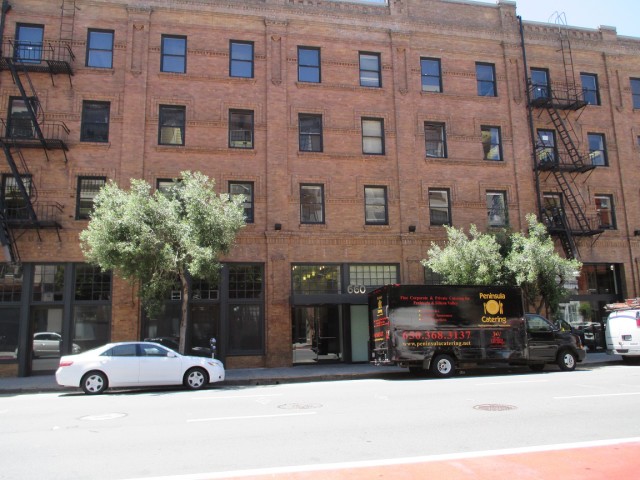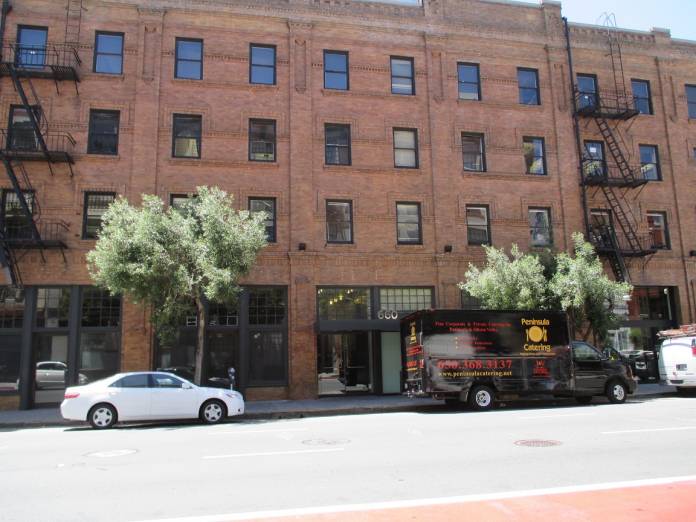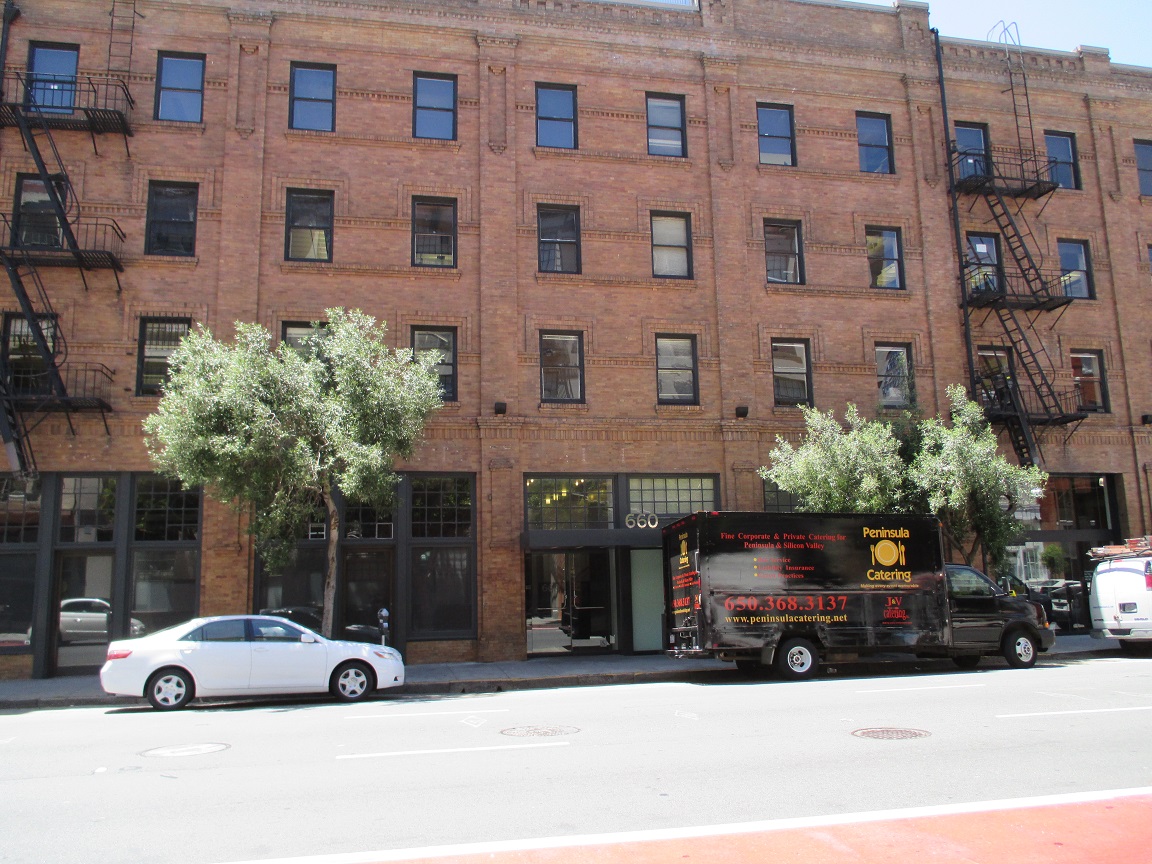At the May 18 meeting of the San Francisco Board of Appeals, attorney James Reuben, a principal of Reuben, Junius & Rose, showed why he is one of the city’s leading permit expediters, lobbyists hired by developers and landlords to shepherd their projects through the Planning Department’s approval process. Using charm and guile, Reuben forestalled the city’s final day of reckoning with the Rabin family, his clients and the owners of 660 Third St., the four-story SoMa building zoned for light industry that the Rabins illegally converted into offices in the 1990s.

The 80,000 square-foot building is among the million-plus square feet of office, industrial, multifamily and retail commercial property in the portfolio of the Rabin Management Company, an arm of Rabin International, a family-held industrial auction, i.e., liquidator, and real estate investment company headquartered in San Francisco.
Compared with the San Francisco Flower Mart and the San Francisco Design Center—Production, Distribution, and Repair-zoned properties whose threatened conversions have recently been in the headlines—80,000 square feet is small. But it’s the covert, illicit transformation of obscure light industrial space into offices—typically, tech offices—that accounts for the bulk of PDR’s severe attrition in San Francisco.
The history of 660 Third St. epitomizes that transformation. The May 18 presentations to the Board of Appeals omitted key elements of that history; the following account restores them to their proper places.
It begins with actions taken by the lawyer who intially represented the Rabins, Reuben’s colleague David Silverman. To appreciate Reuben’s maneuvers at the Board of Appeals, you have to comprehend Silverman’s. You also have to grasp the ways in which, until recently, the Planning Department has facilitated the illegal conversion of PDR-zoned property into offices.
Silverman’s first stop was the Historic Preservation Commission. 660 Third St. is located in the Service/Light Industrial (SLI) Zoning District. Intended to protect PDR uses, whose comparatively low worker-to-square-footage densities make office rents prohibitive, SLI prohibits general office uses — except in Landmarked buildings or Contributory Buildings in a Historic District that have obtained a Conditional Use Authorization (CU). Only the Planning Commission can issue a CU.
660 Third St. is in the South End Landmark District. But before the building could get a CU from the Planning Commission, it had to be either landmarked or designated a Contributory Building.
Silverman’s initial job was to persuade the commission that without office rents, the owners could not afford to restore or preserve the structure. That’s because, as planner Rich Sucré wrote in the draft resolution that he prepared for the commission’s February 19 meeting, in order for a project to qualify for a CU, it must first “be determined that allowing the [office] use will enhance the feasibility of preserving the landmark, significant, or contributory building.”
The Historic Preservation Commission was apparently persuaded, for it unanimously approved the resolution. As I wrote in May 2014,
It’s reasonable to think that a significant factor in that approval was the testimony of the Rabins’ lawyer, Silverman, the only person to speak at public comment. Silverman told the commission: “the building’s vacant.”
That’s hard to believe. In the executive summary that he prepared for the Planning Commission’s March 27 meeting (the item was continued to April 3 and then May 1), 660 Third St., Sucré wrote, “is occupied by office tenants.”
Did they all move in between February 19 and March 27?
They did not: calls to two tenants, Frog Design and Healthline, revealed that they’ve both been at the address for years, and a third longtime tenant is the commercial realty that manages the building, Polatnick Properties.
Strikingly, the memo that Sucré presented to the Historic Preservation Commission said nothing about the building’s past or current tenants or lack thereof. Nor did Sucré challenge Silverman’s assertion that the building was vacant. The commissioners, for their part, didn’t ask. But absent that information, as well as a pro forma laying out the project’s financials, how could it be determined that the conversion from PDR to office use was necessary to restore and maintain the building?
Next stop, the Planning Commission. At the commission’s May 1 meeting, Silverman was accompanied by Ariel and Daniel Rabin. When Planning Commissioner Gwyneth Borden asked about 660 Third’s rental history, Ariel Rabin’s reply only half-jibed with Silverman’s testimony to the Historic Preservation Commission that the building was empty due to a lack of PDR demand.
“We’re not really allowing offices,” Rabin said. “We’ve always had people who are building things there…As a family we’ve been offered ridiculous sums of money to convert it to fancy offices,” even as “we’ve always struggled to lease the property because PDR users have not stepped forward when we have vacant space.”

Regrettably, nobody asked how much rent they’d been asking. But anyone who’s stepped into the lobby at 660 Third St. and scanned the tenant roster on the wall knows that the place is all fancy offices. Anyone who views Polatnick Properties’ website knows that it’s been that way for a long time. The broker boasts that in 1996,
the building went through a complete renovation, which included seismic upgrade and code compliance for office, retail and tenant improvements….With an eye for the New Economy, Polatnick tripled the electrical power to the facility and installed fiber optics, the first commercial building in San Francisco to do so, making it one of the most sought after multi-media addresses in multimedia gulch.
After Ariel Rabin spoke, Silverman qualified his client’s claim about not allowing offices. “It’s a mix [of office and PDR],” said the lawyer.
Unlike the Historic Preservation Commission, then, the Planning Commission knew that the building had office tenants. It also knew that the Rabins had owned the building for a long time. With that information in mind, Borden said, “I’m not clear why the change is necessary. It’s not a new owner in which the cost is high.”
Other assertions Silverman made to the Planning Commission were flat-out counterfactual. His March 10 submittal stated that PDR uses at 660 Third St. were “precluded” by a lack of parking and loading facilities. Anyone who’s visited the site knows that the building, which backs onto Ritch Street, a quiet alley, has a loading dock and two freight elevators in the rear. Polatnick Properties’ current ads for the building mention on-site parking.
The Planning Department had originally recommended a full office conversion. The staff report for the September 11 hearing changed that recommendation to approval of up to 49,999 square feet of office use. “Given the extent of the office projects currently on-file with the Planning Department,” said the report,” ‘large cap’ office development allocations [for projects with at least 50,000 gross square footage] will become increasingly scarce over the next year or two.” By contrast, “the ‘small cap’ office development limitation program [for projects between 25,000 and 49,0000 gsf of office space]…has ample available square footage.” At the hearing Planning Director Rahaim recommended reducing the office conversion to 40,000 square feet—in other words, to half the building—because enforcing mixed uses on different floors would be impracticable.
The case for full conversion was further weakened by some planning commissioners’ concerns about the diminishing amount of light industrial space in San Francisco, a plight amply publicized by SFMade (Hillis); and the looming prospect of an “office city” whose homogeneous economy would be vulnerable to downturns (Richards). Commissioner Richards also said he’d done his own research and seen a loading dock at the building.
Commissioner Antonini, who’d initially advocated full conversion, then asked Silverman about his “preference.” Silverman replied: “My sense of the commission is that they’re moving in the direction of a half-and-half building, which we would accept.”
A half office and half PDR building is what the Planning Commission authorized.
At first it seemed as if the Rabins had accepted the Planning Commission’s decision. They did not file an appeal, and on December 29 they paid the city $947,604 in development impact fees. For once, it appeared, the city had cracked down on illicit office conversions of PDR space and enforced its zoning regulations.
Not so fast: It turned out that the Rabins did not evict the office tenants on the two bottom floors.
On April 2, 2015, the Planning Department issued a Notice of Violation and Penalty (NOV) finding that the building, with office uses at all levels, violated the Planning Commission’s decisions limiting approval of the office conversion to the third and fourth floors.
The Rabins did not pay the penalty ($250 a day) and appealed the NOV. They asked the city’s Zoning Administrator, Scott Sanchez, to hold a hearing at which they could present information to demonstrate why they believed the Notice had been issued in error.
The Zoning Administrator hearing took place on the afternoon of May 19 around a conference table in a small meeting room in the Planning Department’s offices. This time Ariel and Daniel Rabin were accompanied by two attorneys, Silverman and Reuben.
Reuben did almost all the talking. He accused the Planning Commission of having “abused its discretion.” In support of this charge, he did not quote a single provision of the city’s Planning Code or a single approved permit for office conversion. Instead, he cited precedent. He said that he couldn’t find “a single prior application [of the sort his firm had filed for 660 Third] that had been denied in the past” and alleged that “there’s never been a No vote under the Code section at hand.”
That argument was elaborated by Silverman in a May 19, 2015, letter to Sanchez. “[M]ost of the historic buildings in the neighborhood,” he wrote, “have already received conditional use approval for office use, including the very similar building located directly across the street at 665 Third Street.” Asserting that “[t]here is no material difference” between the two buildings, Silverman claimed that “[i]t would be a gross injustice to the Rabin Family to treat them and their Building differently…” The letter also noted that the planning staff had “placed the matter on the Commission’s [May 1] Consent Calendar, reflecting its routine nature up to that point.”
Silverman didn’t note that at the September 11 hearing, mindful of office allocation caps, the staff had changed its recommendation from full conversion to 49,000 square feet. Nor did he say that to make enforcement feasible, the city’s planning director had recommended reducing the conversion to half the building. Planning commissioners’ concerns about the shrinkage and corresponding shortage of PDR pace in San Francisco also went unmentioned.
In Silverman’s telling, the only explanation for the Planning Commission’s half-and-half decision was bad timing. The Rabins’ application, he maintained,
would have been approved in May 2014, just as all such applications had been approved in the past, but for the fact that it got swept into a maelstrom created by an unrelated project at Showplace Square,…a historic [PDR-zoned] building where approximately half of the tenants were apparently concerned about their continued occupancy.”
It’s true that tenants at Showplace Square fought their landlord’s plans to displace them in behalf of Pinterest; that the fight was in the news; and that the landlords ultimately lost. But when the Rabins’ application came before the Planning Commission on May 1, 2014, the tenants had yet to mobilize, and the controversy hadn’t gone public.
At the Zoning Administrator hearing, Sanchez asked Reuben if his clients had appealed the commission’s decision the past September.
Reuben replied that they had not, adding, “We were a little bit flabbergasted at the time”—and apparently, for months afterwards, seeing as how in late December they paid the city nearly a million dollars in development impact fees.
Sanchez also asked if there had been any permits to convert 660 Third into office use.
Reuben replied that he “believed there are some permits” but “[didn’t] know that they were signed off by the Planning Department.”
As 48 hills reported, as of late April 2014, since 1984, the Department of Building Inspection had issued 65 building permits for work at 660 Third worth millions of dollars. But as Reuben himself intimated, building permits are very different from approval by the Planning Department.
The Zoning Administrator inquired about the current makeup of the building. Silverman had told the Historic Preservation Commission that it was an empty PDR building; he’d told the Planning Commission that it was a mix of PDR and office; Reuben presented a chart showing all office tenants: Healthline, “similar to a Web MD”; Juice Box Games, which designs games for mobile use; Building Management, i.e., Polatnick Properties.
The attorney said he’d advised his clients that they had four options:
- “Do nothing.”
- “Go into Planning and submit a grandfathering application. We think we have grounds for doing this,” bit it’s “difficult to convince Planning” in such matters.
- “[L]egalize the building.”
- “Wait for the Central SoMa Plan” to wipe out the current zoning with regulations that upzone the entire area to allow offices. “It looked as if [the plan] would have been approved by now. That would have been the cleanest, most direct and most expedited way to go.”
But they chose Number 3.
Zoning administrator hearings are relatively informal affairs. There are time limits: the project sponsor has five minutes to make a presentation and three minutes for a rebuttal. But attendees are also allowed to interject brief replies and comments.
I decided to speak up. As I reported:
I said that that the reason that the Historic Preservation Commission designated 660 Third as an historic resource was that “Mr. Silverman told them that the building was vacant, and that the owners couldn’t find any PDR tenants.” That description, I said, was “inaccurate.” Nevertheless it went unchallenged at the HPC, which reasoned that if no PDR tenants could be found, what’s the point of keeping the PDR zoning?
Reuben turned to Silverman and asked if he’d said “the building was vacant.” Silverman denied it and claimed that what he’d really said was that “the building was vacant”—in other words, it was empty … before they’d rented it out as offices.
After the meeting I checked the official transcript of the hearing at the Historic Preservation Commission. According to that document, Silverman said:
There’s no PDR being lost because the building is vacant. It’s a very hard building to find tenants for.
On August 28, 2015, the Zoning Administrator ruled that the Rabins were in violation of Planning Code Section 174 and its requirement that “every condition, stipulation, special restriction, and other limitation under the Planning Code shall be complied within development and use of land and structures.”
Remarkably, on September 11, 2015, a year to the day of the Planning Commission’s decision, the Rabins appealed Sanchez’s ruling, alleging that
- The Zoning Administrator prejudicially abused his discretion;
- The Zoning Administrator has not proceeded in the manner required by law;
- The Zoning Administrator Decision is not supported by the findings; and
- The findings of the Zoning Administrator Decision are not supported by the evidence.
Originally scheduled for October 28, the Board of Appeals hearing was repeatedly delayed until May 18, 2016.
The Board of Appeals is described on its website as “the last stop in the City’s decision making process for appeals regarding a wide range of City determinations involving permits, licenses, and other entitlements.” It’s where city staff defend the actions taken by their colleagues, an assignment that can make for unusually revealing exchanges between staff and members of the public. The Zoning Administrator represents the Planning Department and Planning Commission. According to the “Special Instructions for Parties” set forth on the Board’s website,
Decisions by the Zoning Administrator (ZA), other than Variance decisions, require that the Board defer to the ZA unless the Board find that the ZA erred or abused his or her discretion.
and
In deciding a case, the Board may only uphold, overturn, or place conditions on a departmental decision; it cannot remand (send back) a decision to the underlying department for further review or action.
Getting the Board to overturn or modify a departmental decision is a challenging assignment: appellants need four out of the five Board members to vote in their favor.
The five members are appointed for staggered four-year terms. Three are appointed by the mayor and two by the president of the Board of Supervisors. The current members are Darryl Honda, President; Frank Fung, Vice-President; Ann Lazarus, Rick Swig, and Robbie Wilson. On May 18, Wilson was absent. That meant that appellants who wanted a departmental decision to be modified or overturned needed a unanimous vote.
The Board of Appeals is a quasi-judicial body; appellants’ next stop is Superior Court. At the start of its meetings, attendees who wish the Board to give “evidentiary weight” to their testimony are asked to participate in a collective swearing-in. On May 18 almost everyone in the packed chamber rose, raised a right hand, and vowed to tell the truth, the whole truth, and nothing but the truth.
When the board got to 660 Third St., three and a half hours into the meeting, Reuben came forward. The lawyer’s familiarity with the venue was evident from his opening banter with Board Vice-President Frank Fung. “I think your whole firm is here tonight,” said Fung. Reuben amiably concurred: “Has there been a non-Reuben case here tonight?” “That’s a good thing,” Fung quipped.
Then Reuben launched into his appeal. He began by saying, “I’m going to try to come at this presentation a bit differently than the submittals read.”
His November 24, 2015, letter to the Board of Appeals accused the Zoning Administrator of having “acted arbitrarily, capriciously, and unfairly in issuing the NOV,” because building permits issued by the city, “many of [which] were signed by the Planning Department,” give the Rabins “a vested legal right to use the first and second floors of the building as office space.”
At the hearing, Reuben discounted the permits. Acknowledging that “the Planning Department and the Zoning Administrator must live with the record,” he conceded that “there’s no dispute over what that record said….Unfortunately,…the permits don’t tell the true story of what was actually happening in the building.”
He claimed that what was actually happening was office use, even when the building was used as an auction house from1962, when it was purchased by the Rabins’ late father, Irving Rabin, through the 1990s. In 1990 the area was re-zoned SLI. “At that point,” Reuben argued, 660 Third “became a legal, non-conforming office building.” With one minor exception (a short-lived piano store), it’s been occupied by office tenants ever since.
The Zoning Administrator did go by the record. Challenging Reuben’s contention that “office use on the first and second floors is a lawful non-conforming use that was established in 1980,” Sanchez wrote in his brief that
the Appellant fails to provide evidence of any permit to convert the building from warehouse to office (other than Building Permit Application 201411252480, which allows the conversion of the third and fourth floors pursuant to the Planning Commission’ decision.
He proceeded to use the Rabins’ own applications against them, stating that those documents,
as submitted to the Department in 1987 and 2013, list the existing use as warehouse (1987) and auction house with ground floor retail (2013). The Appellant argues that the previous auction house “falls squarely within the definition of ‘office use’”; however, their own application to allow the conversion correctly categorizes the use as “light Manufacturing, Wholesale Sale, Storage” under Planning Code Section 890.54—which is not an office use.”
But just as at the Zoning Administrator hearing, Reuben’s main line of argument at the Board of Appeals turned on precedents, not permits. “Every prior application” of this sort, said the attorney, had been approved by the Planning Commission. “[W]e were employing a provision of the Planning Code that had never been unsuccessful.” Once again, he emphasized the case of 665 Third St., whose illegal conversion from PDR into office had been authorized by the commission in October 2013. Reuben cited legendary land use attorney Sue Hestor, the scourge of scofflaws: “This was the right way to do office conversions.”
And yet the commission had denied the Rabins’ application, offering “no explanation for the decision to approve half” the building.
Reuben supplied one—the same rationale Silverman advanced in his letter to the Zoning Administrator hearing: “the political atmosphere.” Between the October 2013 ruling on 665 Third and the Planning Commission’s May 2014 hearing on 660 Third, “[t]he Pinterest problem hit like a tsunami. If we had reached the finish line six months earlier, before the Pinterest explosion, we would have been approved just like 665 Third St.” Instead, “we became collateral damage.”
So far, Reuben had proceeded along the same lines as he and Silverman had followed a year earlier. Then he took a new tack. In May 2015, he and his colleague had asked the Zoning Administrator to dismiss the Notice of Violation. By contrast, Reuben asked the Board of Appeals to hold the enforcement of the NOV “in abeyance for a year until the new regulations” entailed by the Central SoMa Plan went into effect. Those regulations, he asserted, would allow office uses at 660 Third.
Sanchez cautioned that the Central SoMa Plan was a work in progress. The final version “may make office more permissive;” alternately, “it could require replacement or preservation of PDR.”
Reuben countered, “I don’t think Scott was direct with you. Anything can happen. That’s what happened with Pinterest. But if you read the plan today, it’s office.” He displayed a colorful map from the draft plan showing that the 600 block of Third St. would be re-zoned from SLI to MUO, a designation that allows offices.
That map, however, is out of date. Since issuing the draft Central SoMa Plan in 2013, the Planning Department has proposed refinements in many areas, including PDR. The most recent policy document dealing with PDR, dated March 2015, recommends that buildings with PDR uses in areas currently zoned SLI would be required to maintain 50% of existing PDR space— exactly what the Planning Commission decided for 660 Third.
In any case, as Sanchez pointed out at the Board of Appeals, “A CU may not be required under new zoning, but [the Rabins] would still need an office allocation from the Planning Commission.”
The board was not receptive to Reuben’s proposal for a year-long abeyance of enforcement. What got attention, largely from one board member, was the attorney’s claim that the discrepancy between the commission’s disposals of 660 and 665 Third St. showed that the Planning Commission had treated the Rabins’ application prejudicially due to political sentiment.
Rick Swig asked Sanchez, “What’s the difference between the two buildings?”
The Zoning Administrator said that they were “hard to distinguish, apart from the timing [of the applications].”
Swig: “I hesitate to use the word discrimination but that’s the only word that comes to me. Why would this building be discriminated against, when across the street, there’s no difference?”
In light of Reuben’s narrative, it does look as if the Rabins had been treated unfairly.
But that narrative omits many crucial factors. As already noted:
- The applicants misrepresented the status of the building to both the Historic Preservation and Planning Commissions. If Silverman had told the Historic Preservation Commission that 660 Third was not vacant but had long been occupied by office tenants, that it had been renovated into a high-end office building with correspondingly high-end rents, and that it had loading capacity and parking; and if planner Sucré had corrected these misrepresentations; the commission might not have received its historic designation in the first place.
- The Pinterest controversy blew up after 660 Third’s initial hearing in May 2013. Though it may have influenced the Planning Commission’s half-and-half ruling in September, it couldn’t have played a role in the body’s reluctance to approve the Rabins’ application in May and its decision to continue the hearing until the fall.
- Contrary to Reuben’s assertion, explanations for the half-and-half ruling were provided by both the planning staff (office allocation cap and enforceability) and Planning Commissioners (need to protect the city’s PDR space and to seek a diverse and resilient economy).
- In December 2013 the Rabins paid the city nearly a million dollars in development impact fees, an action that suggests that they’d accepted the Planning Commission’s decision. Reuben’s November 24, 2015 letter to the Board failed to mention that payment. Instead, it intimated that they’d paid nothing: “It should not be overlooked that the Rabins have agreed to pay the City $948,391.00 in mitigation fees in coordination with the Planning Code authorization process [what they would have additionally paid, had the conversion of the entire building been authorized]. The NOV has, among other things, deprived the City of these funds, with no corresponding benefit to the City whatsoever.”
As not already noted, and as Reuben also failed to mention, the authorization processes for 660 and 665 Third St. differed in one very significant way: unlike the request to legalize 665 Third, the proposal to authorize the illegal office conversion of 660 Third generated considerable opposition from the public.
Speaking at the September 11 hearing, the late Jim Meko, president of the SoMa Leadership Council and one of PDR’s staunchest defenders, observed that “[t]he conversion of PDR space to office use has become so routine that when 660 Third first came before this commission, it was on the Consent Calendar.” To Meko, that placement reflected the Planning Department’s indifference toward—not to say, complicity in—the clandestine, illegal displacement of San Francisco’s light industry by offices.
At the May 1 hearing, Mission Economic Development Agency Policy Director Gabriel Medina, referencing San Francisco’s need for manufacturing space and the living-wage employment it provides, asked the Planning Commission to follow a policy of “no net loss of PDR” and accordingly, to maintain 660 Third’s industrial use status.
At both the May and September hearings, representatives of Tenants and Owners Development Corporation, a major SoMa developer and landlord, objected to Rabins’ application. In May TODCO Director of Community Policy Alice Light called the proposed full conversion of 660 Third into offices “a giveaway” and “bad community planning” that “sets a precedent for the eventual loss of all PDR in SoMa.” In September TODCO Executive Director John Elberling endorsed the staff recommendation to convert just half the building into office, a proposal that accorded with TODCO’s own general recommendation “to institute a new system of inclusionary PDR in buildings in South of Market that come to you for conversion or demolition and use as office space.”
And then there was Sue Hestor. Reuben’s allusion to Hestor’s support for the change at 665 Third, coupled with his and Silverman’s insistence that the two buildings are materially the same, implied that she would have also endorsed the conversion of 660 Third.
In fact, Hestor vigorously protested the proposed change at 660 Third. Speaking at public comment at the September 11, 2014, hearing, she slammed the Planning Department for having allowed the illegal conversion of the building:
“Where is the history? How did it get to this state? How did [you] screw up? Why did nobody catch this? I’m not willing to cut staff slack about these illegal conversions anymore, and you shouldn’t either.”
Her charge of dereliction went beyond “the damn [building] permits.” At the May 1 hearing, Hestor upbraided planning staff for having discounted the development impact fees for PDR-zoned buildings coming in for retroactive authorization, thereby both encouraging the displacement of light industrial uses by offices and “cheat[ing] affordable housing and the Muni.”
At the May 1 hearing, Council of Community Housing Organizations Co-Chair Peter Cohen voiced the same objection, criticizing the planners for having “deeply discounted” the fees “for transit and housing, our two biggest infrastructure needs right now.”
As I reported in June 2014, the Planning Department also improperly calculated the impact fees for 665 Third. Instead of charging the owners a Transportation Impact Development Fee of $1,634,077, they asked for $722,408—a difference of $911,669. I suspect that if Hestor had been aware of this error in October, 2013, she would not have praised the department’s handling of 665 Third. (By September, staff had gotten the numbers right for 660 Third.)
The Planning Department made another crucial error with respect to both properties: at a pivotal moment in each authorization process, staff failed to correct the applicant’s misrepresentation of the tenants. At 660 Third, planner Sucré let stand Silverman’s assertion to the Historic Preservation Commission that the building was vacant. At 665 Third, the owner’s representative told the Planning Commission that since 1980s the building had been occupied by office users. Neither that representative nor planning staff, once again Sucré, noted that since 2006, 665 Third had housed Biosciences Laboratories, a biotech incubator, or that one of the biolab’s subtenants was Glowing Plants, a controversial startup that makes DNA-altered, glow-in-the-dark plants. Life-science laboratories are not permitted in the Service-Light Industrial District. In the course of researching my story, I alerted the Planning Department, the Mayor’s Office of Economic and Workforce Development and the city’s Environmental Health Department to the presence of both these illegal uses. Two years later, Biosciences Laboratories and Glowing Plants are still tenants at 665 Third.
In short, the Planning Commission did treat 660 Third St. differently from 665 Third St. and other PDR-zoned historic properties: it abandoned its cavalier attitude toward the Planning Code and gave the city’s light industry some of the respect to which it’s legally entitled. If anything, the commission behaved generously toward the applicants; it had the legal authority to require the entire building to revert to de facto light industrial use.
The Board of Appeals slowly reasoned its way to an action. (Remember: it takes four votes in favor of an appellant’s request to modify or overturn a department decision.)
Board President Darryl Honda asked Sanchez, “What happens if they continue to stay out of compliance until the new legislation,” i.e., the Central SoMa Plan, “is in place?” Sanchez said that the Planning Department would refer the matter to the City Attorney’s office for litigation. Meanwhile, the city would impose a penalty of $250 a day on the Rabins. Honda noted that 40,000 square feet and a $250 dollar-a-day penalty was not much of a disincentive. The Zoning Administrator agreed, stating that the issue had been raised at the Planning Commission.
Board member Ann Lazarus: “I’ll make clear where I stand….There was a Planning Commission decision. I think it was not adhered to. There was a violation. I think it needs to be upheld.”
Honda wondered what would happen next if the Board followed Lazarus’s lead.
Lazarus: “What happens next is not our issue.”
Fung: “It’s hard to fully accept some of the points that were made regarding the political climate….When I looked at the permits,…there was a pattern of office use. I’m not sure that I’m willing to make that determination that it is a office use in any form or manner, because we don’t have that authority, but we do have the authority to give them a little breathing time. We could continue this for six months….[The Rabins] will have to make their own business decision based on what may occur or may not occur with enforcement.”
Honda: “I would lean toward a continuance but I would not lean toward the penalties not to keep on accruing, because money’s not the issue here at this point.”
For Fung, the issue was timing. The Rabins “need to terminate those leases.” The continuance would give them an ability to do that.
Honda: “But I’m kind of with Ann. A decision was made, they knew what the decision was, and they went forward with [keeping office uses on the two ground floors].”
Lazarus: “I will not support a continuance.”
Swig said he was “kind of with Fung” and then averred that “the problem we’re facing” was the political context—“a completely unrelated issue….We have to conjecture this, obviously. That’s why I pointed to the building across the street,… which the Zoning Administrator completely agreed, was a similar project, seemed to have sailed through….And then across town, a few blocks away, there’s the Pinterest effect. An emotional political climate ensued. Bad timing, guys….And that’s what bothers me.”
Honda was skeptical. “Political climate or not,” he said, “they’ve owned the building since the Sixties. You want to say the political climate since the Sixties has been like that?”
Swig demurred, but noted that the building owner had taken the initiative “to seemingly recognize the conditions” and “to try to resolve” them. He said he’d support a continuance.
Lazarus: “But there was a decision made by the Planning Commission after a very long process.”
Swig: “That’s also true.”
Fung: “I think we all understand quite well what that implies.”
A long silence. Then Fung moved to continue the hearing for six months.
The Board’s Executive Director, Cynthia Goldstein, offered him dates in November and December. Fung chose December 7. Goldstein asked, “Do you want to say why you’re continuing it to that date, what you want to see happen between now and then, or not?”
Fung: “Not.”
The Board of Appeals voted was 3-1 to continue its hearing on the Rabins’ appeal of the NOV until December 7, 2016.
The Rabins may be hedging their bets in the hope that the Board of Appeals will give them “relief” in December. As of June 1, Polatnick Properties was advertising an 8,467 square-foot office space (“2 conference rooms, 10 office-breakout rooms and a large open seating area”) on the ground floor of 660 Third, “a classic brick and timber building,” for sublease or direct lease with a “Negotiable” term. An 11,846 square-foot office space on the 3rd floor was being offered for a 5 -10-year lease “with the landlord.”
Whatever the brothers are thinking, for the better part of two years, they’ve openly defied city law. Now the Board of Appeals has given them license to continue that defiance.
But like the Historic Preservation Commission, and unlike the Planning Commission, the Board of Appeals acted in the absence of crucial information about 660 Third’s recent history.
Let’s hope that when Reuben and the Rabins come before the agency again on December 7, a fuller grasp of the facts will lead the Board to do the right thing and uphold the Planning Commission’s ruling that the bottom two floors of 660 Third must revert to PDR.





